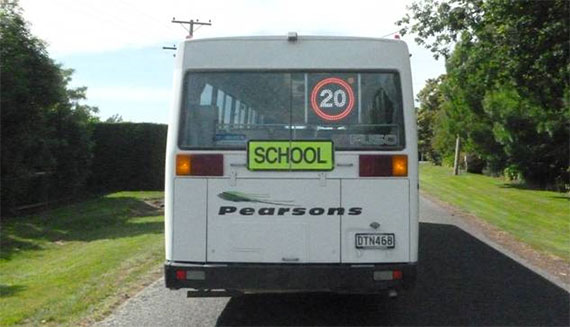Motorists in the Ashburton district have slowed down when passing stationary school buses since the Either way it’s 20k bus trial began but are still travelling at twice the legal speed limit.
Preliminary data shows there has been an average drop in speeds past stationary school buses stopped for children to get on and off from 80km/h to 40km/h on the open road since flashing 20km/h signs were fitted to buses in the area two months ago.

“While this is a great start, drivers need to be aware that the legal speed limit is 20km/h - in both directions,” says the NZ Transport Agency’s Safety Programme Co-ordinator Lee Wright.
The Ashburton Police have been enforcing the campaign since October and Sergeant Stephen Burgerhout says it has been good to see a heightened awareness and good compliance among drivers in lowering their speeds.
“However, drivers still need to slow down even further. There are still drivers who are ignoring the message. We have one local truck driver who will appear in court this month after having his licence suspended; he was travelling 70km/h past a stationary school bus.”
The Either way it’s 20k is a year-long trial aimed at finding ways of tackle the problem of poor driver awareness of the speed limit around school buses and the need for drivers to slow down to keep children safe.
Ms Wright says if vehicle speeds are lower when passing stationary school buses, in the event of a child running out from behind a bus and being hit, the greater their chance of survival.
Mark Cook, Manager of Pearsons Coachlines, on whose buses the flashing 20km signs have been fitted for the trial, says his drivers have noticed a reduction in speeds past their buses, particularly on main roads and highways.
“About 90% of motorists seem to be slowing down to 20km/h. We do, however, need to keep up the campaign and keep raising awareness within our community that it is 20km/h past a stationary school bus. This is about our children, about saving lives and the police need to keep enforcing the message.”
Ms Wright says there is significant national interest in the trial. “I would receive about half a dozen emails a week from communities and councils, asking how the trial is going and when the signs will be available for use.
“If through the trial it is shown that use of the signs reduces speeds, it is hoped these will approved for legal use and will be able to be used throughout New Zealand.”
Editor’s Notes:
The trial is being conducted by TERNZ Ltd, with funding from the Road Safety Trust and support from the NZ Transport Agency, Rural Women New Zealand and Ashburton District Council.
In the last 26 years, 23 children have been killed and 47 seriously injured after being struck by cars travelling at speed.
The trial kicked off in June with a concerted effort to raise driver awareness of the legal speed limit. For the last few months, drivers in the Ashburton district have been bombarded with the Either Way its 20K message through billboards, posters, print ads and wide media coverage.
The second stage involved the installation of the LED 20km/h signs on local school buses in August. These signs automatically light up when the bus door opens, and include flashing ‘wig wag’ lights to alert drivers that a bus is stopping and of the need to slow to 20km/h.
Ashburton was chosen as the location for the trial thanks to the support and co-operation of bus operator, Pearsons Coachlines, which services 16 schools in the district. Its fleet of 30 buses has been fitted with the active 20K signs, front and back.
The campaign also has the backing of Rural Women New Zealand, which helped conduct a pre-trial survey, highlighting very low driver awareness of the 20km/h road code rule.